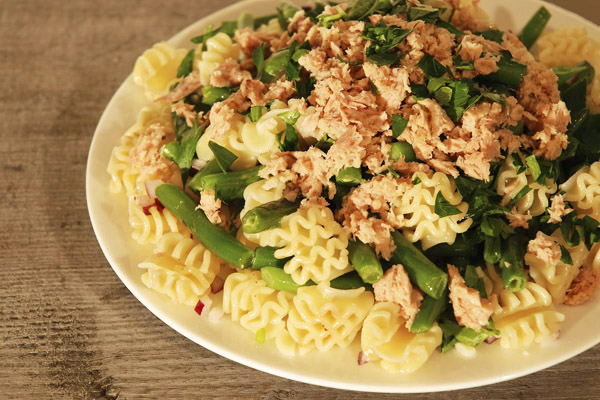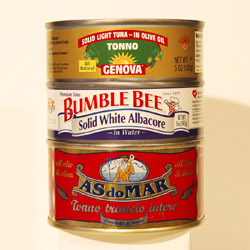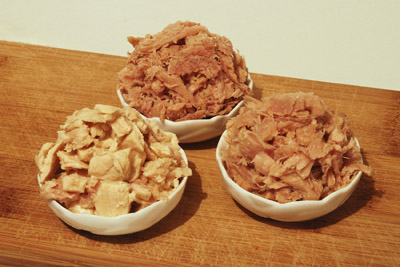Somewhere between the former hospital of San Lorenzo and the Porta Nuova we began to wilt. The sun blazed. The children whined. The paintings we’d been to see had been uninspiring. And as usual, we’d gotten a late start so we were out during the mezzojourno – that time of day when all self-respecting Italians are supposed to be lunching with mama and the only creatures left on the street are stray dogs and slow tourists.
 Down a few steps from the cobbled street we found relief in a cool restaurant where customers ordered enormous salads by number. Number 34 was an Italian take on Salad Niçoise – arugula, green beans and tuna – layered so that tuna was the crown. And royal that tuna was indeed!
Down a few steps from the cobbled street we found relief in a cool restaurant where customers ordered enormous salads by number. Number 34 was an Italian take on Salad Niçoise – arugula, green beans and tuna – layered so that tuna was the crown. And royal that tuna was indeed!
Italian tuna, much beloved by Italians, is done a little differently than the tuna I grew up on. According to Tom Stobart, Mediterranean tuna are caught in a system of nets (a Sicilian tuna trap) at the peak of their condition and specially handled to achieve tuna that is more richly flavored than domestic albacore, and with a fuller texture. The very best – and most expensive – is ‘ventresca’, from the lower part of the fish.
Meanwhile, back here at Chez Bullhog, we include tuna on the antipasto plate every time we fire up our oven for a group. It’s an excellent counterpoint to olives, meats and veggies. And ever since that number 34 salad, it’s been Italian tuna whenever possible. Here is one of our favorite recipes.
You can also follow this link to Piquillo Peppers stuffed with Smoked Paprika Tuna which are very nice when Italian Tuna is used in place of albacore.
Radiatore Tonnato (Radiatore Pasta with Green Beans and Italian Tuna)
Serves 8 as part of a mixed antipasto plate
½ pound shaped dry pasta (radiatore, rotini or farfalle)
1 can (150 – 200 grams) Italian tuna
(or substitute a can of domestic albacore if you must)
8 ounces fresh green beans, topped and tailed
1 large clove garlic, chopped
¼ cup finely chopped red onion (about 1½ ounces)
2 Tablespoons chopped Italian flatleaf parsley
½ teaspoon salt
1/8 teaspoon black pepper
1 Tablespoon mild vinegar
Cook the pasta: Bring 3 quarts water to a boil and cook the pasta for 7 minutes, until al dente. Remove to a colander and run cold water over it to stop the cooking process. Put to one side to drain.
Drain the Italian tuna: Remove the lid from the tuna, and squeeze the olive oil into a ramekin or small bowl to be used in future steps. Set the tuna to one side.
Blanch and fry the beans: Bring another quart of water to a boil and plunge half the beans into it. Boil for 2 minutes, and then remove the beans and cool under the tap. Plunge the rest of the beans in the boiling water and repeat.
Heat a 10 or 12 inch frying pan over medium heat, put half the tuna oil into it and chop the green beans roughly into thirds. Fry the beans with the chopped garlic for 3 or 4 minutes, keeping the pan quite hot. Turn the beans with a spatula every minute or so, until they are heated through and sputtering. Remove to the pasta colander to let cool.
Assemble and serve: Put the cooled pasta, the cooled green beans and the chopped red onion into a salad bowl. Sprinkle on half the flat-leaf parsley, top with all of the tuna, and then sprinkle on the rest of the parsley.
Pour on the rest of the olive oil from the tuna can, the salt and pepper, and the vinegar. Toss the pasta lightly to incorporate.
Either serve immediately, or cover with plastic to hold until ready. This dish can be made several hours ahead of time.
Final note: I tried all the represented tunas in preparation for this recipe. While both Italian tunas have a noticeable difference in flavor from the American style, there is not enough difference in flavor between the two Italian brands for me to recommend one over the other. Although the As do Mar has a prettier label, and costs more than twice what the Tonno Genovo does, it has a slightly inferior texture and only marginally better flavor. I am inclined to recommend the Genova tuna, mainly because it is available in major markets and is cheaper. I challenge the As do Mar people to raise their level of quality to meet their elevated prices and show us Americans what Italian tuna is all about.




I’ve never tried Italian Tuna but it sounds great. Thanks for the recipe and intersting info about a dif type of tuna to explore.
Yes, have been using Tonno Genovo for years to make various salad-pasta-vegetable dishes and never disappointed. This looks absolutely splendid!
I love that Tuna, I always eat it on a bed of greens with provolone that bites you back! I love it in macaroni salad as well, this such a healthy dish, love the colors. Simple and delicious…I could never eat albacore hate it…nothing like italian tuna! thanks for sending to me 🙂
I’m really pleased I found this website. I am going to try this recipe over the weekend.
sounds really good. I can easily give this a try!
Nice recipe. I enjoy italian tuna with my warm potato salad.
I do not even know how I ended up here, but I thought this post was great. I do not know who you are but definitely you’re going to a famous blogger if you are not already 😉 Cheers!
I have been reading your content Italian Tuna and the Antipasto Plate | Sortachef and they are too much useful for me to read something new and intresting. And You can also view our web also best hyip monitors.